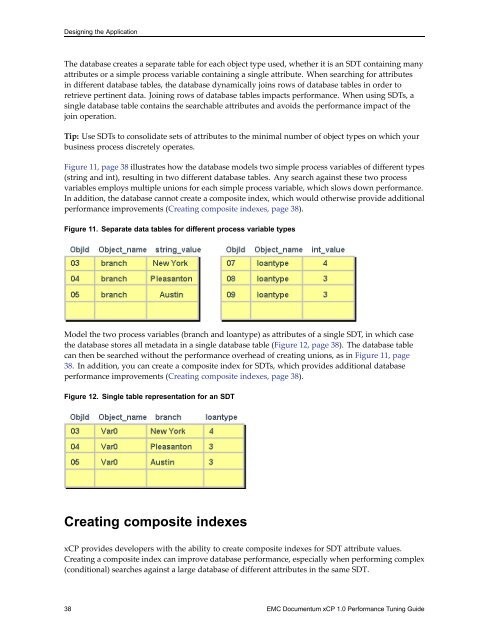Performance Tuning Guide - EMC Community Network
Performance Tuning Guide - EMC Community Network
Performance Tuning Guide - EMC Community Network
Create successful ePaper yourself
Turn your PDF publications into a flip-book with our unique Google optimized e-Paper software.
Designing the Application<br />
The database creates a separate table for each object type used, whether it is an SDT containing many<br />
attributes or a simple process variable containing a single attribute. When searching for attributes<br />
in different database tables, the database dynamically joins rows of database tables in order to<br />
retrieve pertinent data. Joining rows of database tables impacts performance. When using SDTs, a<br />
single database table contains the searchable attributes and avoids the performance impact of the<br />
join operation.<br />
Tip: Use SDTs to consolidate sets of attributes to the minimal number of object types on which your<br />
business process discretely operates.<br />
Figure 11, page 38 illustrates how the database models two simple process variables of different types<br />
(string and int), resulting in two different database tables. Any search against these two process<br />
variables employs multiple unions for each simple process variable, which slows down performance.<br />
In addition, the database cannot create a composite index, which would otherwise provide additional<br />
performance improvements (Creating composite indexes, page 38).<br />
Figure 11. Separate data tables for different process variable types<br />
Model the two process variables (branch and loantype) as attributes of a single SDT, in which case<br />
the database stores all metadata in a single database table (Figure 12, page 38). The database table<br />
can then be searched without the performance overhead of creating unions, as in Figure 11, page<br />
38. In addition, you can create a composite index for SDTs, which provides additional database<br />
performance improvements (Creating composite indexes, page 38).<br />
Figure 12. Single table representation for an SDT<br />
Creating composite indexes<br />
xCP provides developers with the ability to create composite indexes for SDT attribute values.<br />
Creating a composite index can improve database performance, especially when performing complex<br />
(conditional) searches against a large database of different attributes in the same SDT.<br />
38 <strong>EMC</strong> Documentum xCP 1.0 <strong>Performance</strong> <strong>Tuning</strong> <strong>Guide</strong>

















